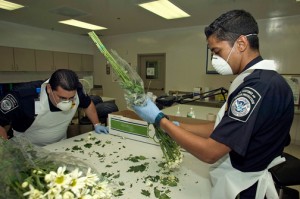Customs inspects millions of Valentine’s Day flowers


While a relatively small number of harmful pests are found among the millions of stems inspected, one of the most serious diseases that can be introduced via imported flowers is chrysanthemum white rust. (Credit: CBP)
A day ahead of Valentine’s Day, when millions will express their love and appreciation for one another with flowers, the U.S. Customs and Border Patrol detailed how it has been keeping busy inspecting shipments of imported cut flowers to prevent the spread of insects or pests that may damage national and local agriculture.
The CPB is especially busy in Puerto Rico, where last year agents inspected 5.1 million stems of cut flowers imported from various destinations in South America. The statistic put the ports of San Juan and Aguadilla among the top 10 in the United States in terms of the volume of imported cut flowers.
“Agriculture inspections are a crucial part of the inspection process for items entering into the country,” said Marcelino Borges, director of Field Operations for Puerto Rico and the U.S. Virgin Islands. “A single dangerous pest could cause millions of dollars of damage to our nation’s crops.”
The most common type of insects intercepted in these cut flower imports are Tetranychus sp. (mites), Aphididae (Aphids), Agromyzidae (Miner Flies) and Noctuidae (moths).
While a relatively small number of harmful pests are found among the millions of stems inspected, one of the most serious diseases that can be introduced via imported flowers is chrysanthemum white rust. If established in the United States, the disease could decimate the U.S. chrysanthemum industry.
Other agricultural pests and diseases capable of destroying our nation’s crops or forests include the Emerald ash borer, the Asian long-horned beetle, citrus canker, and the Khapra beetle
Nationally, CBP processed approximately 842.2 million cut flower stems during the 2012 Valentine’s season from Jan. 1 to Feb. 14, compared to 802.5 million stems processed during the 2011 season — an increase of 4.9 percent. According to the U.S. Census Bureau, the value of imports for cut flowers and buds for bouquets in 2011 surpassed $880.8 million.

The top 10 ports of entry, by volume (number of stems), that processed shipments of cut flower imports for the 2012 Valentine’s season.
Most of the cut flower shipments are imported from South America, primarily Colombia, with 536.1 million stems or 67 percent, followed by Ecuador with 194 million stems or 23 percent.
Miami ranks first among U.S. ports of entry for shipments of cut flower imports, followed by Los Angeles. The quantity of imported cut flowers processed by both ports during the 2012 Valentine’s season increased 5.7 percent compared to 2011 season.
During calendar year 2012, CBP processed approximately 5.1 billion cut flower stems and Miami alone processed 4.3 billion stems.
The imported cut flowers inspection process resulted in a total of 2,439 pest interceptions nationally. Miami intercepted 1,394 pests, followed by Los Angeles with 371 pests. In Aguadilla, 118 pests were intercepted and in San Juan 90.









